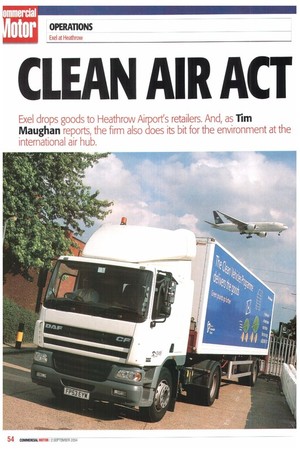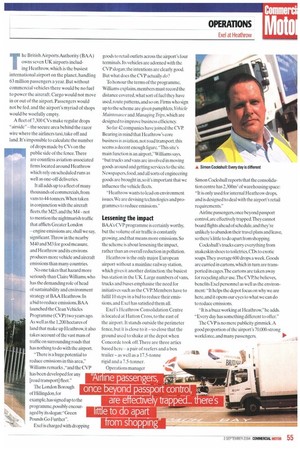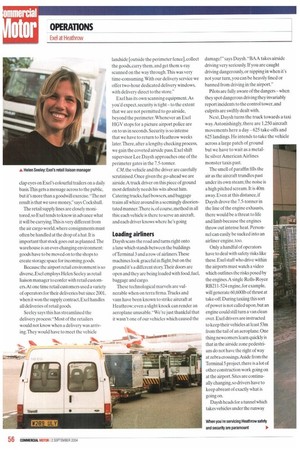CLEAN A 1 R ACT
Page 54

Page 55

Page 56

Page 57

If you've noticed an error in this article please click here to report it so we can fix it.
Exel drops goods to Heathrow Airport's retailers. And, as Tim
Maughan reports, the firm also does its bit for the environment at the
international air hub.
The British Airports Authority (BAA) owns seven UK airports including Heathrow, which is the busiest international airport on the planet, handling 63 million passengers a year. But without commercial vehicles there would be no fuel to power the aircraft. Cargo would not move in or out of the airport. Passengers would not be fed, and the airport's myriad of shops would be woefully empty.
A fleet of 7,300 CVs make regular drops -airside"the secure area behind the razor wire where the airliners taxi, take off and land. It's impossible to calculate the number of drops made by CVs on the public side of the fence.There are countless aviation-associated firms located around Heathrow which rely on scheduled runs as well as one-off deliveries.
It all adds up to a fleet of many thousands of commercials, from vans to 44-tonners.When taken in conjunction with the aircraft fleets, the M25, and the M4 -not to mention the nightmarish traffic that afflicts Greater London engine emissions are, shall we say, significant.Throw in the nearby M40 and M3 for good measure, and Heathrow and its environs produces more vehicle and aircraft emissions than many countries.
No one takes that hazard more seriously than Claire Williams, who has the demanding role of head of sustainability and environment strategy at BAA Heathrow. In a bid to reduce emissions, BAA launched the Clean Vehicles Programme (CVP) two years ago. As well as the 1,200 hectares of land that make up Heathrow, it also takes account of the vast mass of traffic on surrounding roads that has nothing to do with the airport.
"There is a huge potential to reduce emissions in this area," Williams remarks ,"and the CVP has been developed for any [road transport] fleet."
The London Borough of Hillingdon, for example, has signed up to the programme, possibly encouraged by its slogan: "Green Pounds Go Further".
Exel is charged with dropping goods to retail outlets across the airport's four terminals. Its vehicles are adorned with the CVP slogan: the intentions are clearly good. But what does the CVP actually do?
To honour the terms of the programme, Williams explains, members must record the distance covered, what sort of fuel they have used, route patterns, and so on. Firms who sign up to the scheme are given pamphlets, Vehicle Maintenance and Managing Trips, which are designed to improve business efficiency.
So far 42 companies have joined the CV?. Bearing in mind that Heathrow's core business is aviation.not road transport, this seems a decent enough figure. "This site's main function is an airport," Williams says, "but trucks and vans are involved in moving goods around and getting services to the site. Newspapers, food, and all sorts of engineering goods are brought in.so it's important that we influence the vehicle fleets.
"Heathrow wants to lead on environment issues. We are devising technologies and programmes to reduce emissions."
Lessening the impact
BAA's CVP programme is certainly worthy, but the volume of air traffic is constantly growing, and that means more emissions. So the scheme is about lessening the impact, rather than an overall reduction in pollution.
Heathrow is the only major European airport without a mainline railway station, which gives it another distinction: the busiest bus station in the UK. Large numbers of vans, trucks and buses emphasise the need for initiatives such as the CVP. Members have to fulfil 10 steps in a bid to reduce their emissions, and Exel has satisfied them all.
Exel's Heathrow Consolidation Centre is located at Hatton Cross, to the east of the airport. It stands outside the perimeter fence, but it is close to it so close that the ground used to shake at the depot when Concorde took off.There are three artics based here a pair of reefers and a box trailer as well as a 17.5-tonne .e rigid and a 7.5-tonner. / Operations manager Simon Cockshull reports that the consolidation centre has 2,300m3 of warehousing space: "It is only used for internal Heathrow drops, and is designed to deal with the airport's retail requirements."
Airline passengers, once beyond passport control, are effectively trapped.They cannot board flights ahead of schedule, and they're unlikely to abandon their travel plans and leave, so there's little to do apart from shopping.
Cockshull's trucks carry everything from snakeskin shoes to toiletries, CDs to exotic soaps.They average 600 drops a week. Goods are carried in cartons, which in turn are transported in cages.The cartons are taken away for recycling after use.The CVP, he believes, benefits Exel personnel as well as the environment: "It helps the depot focus on why we are here, and it opens our eyes to what we can do to reduce emissions.
"It is a buzz working at Heathrow," he adds. "Every day has something different to offer."
The CVP is no mere publicity gimmick.A good proportion of the airport's 70,000-strong workforce, and many passengers, clap eyes on Exel's colourful trailers on a daily basis, This gets a message across to the public. but it's more than a goodwill exercise. "The net result is that we save money," says Cockshull.
The retail supply lines are closely monitored.so Exel tends to know in advance what it will be carrying. This is very different from the air cargo world, where consignments must often be handled at the drop of a hat. It is important that stock goes out as planned.The warehouse is an ever-changing environment: goods have to be moved on to the shops to create storage space for incoming goods.
Because the airport retail environment is so diverse, Exel employs Helen Seeley as retail liaison manager to confer with retail customers.At one time retail customers used a variety of operators for their deliveries but since 2001, when it won the supply contract, Exel handles all deliveries of retail goods.
Seeley says this has streamlined the delivery process: -Most of the retailers would not know when a delivery was arriving.They would have to meet the vehicle landside [outside the perimeter fence], collect the goods, carry them, and get them x-ray scanned on the way through.This was very time-consuming. With our delivery service we offer two-hour dedicated delivery windows, with delivery direct to the store."
Exel has its own scanning equipment.As you'd expect, security is tight to the extent that we are not permitted to go airside, beyond the perimeter.Whenever an Exel HGV stops for a picture airport police are on to us in seconds. Security is so intense that we have to return to Heathrow weeks later.There, after a lengthy checking process, we gain the coveted airside pass. Exel shift supervisor Lee Daysh approaches one of the perimeter gates in the 7.5-tonner.
CM, the vehicle and the driver are carefully scrutinised. Once given the go-ahead we are airside. A truck driver on this piece of ground most definitely needs his wits about him. Catering trucks, fuel bowsers, and baggage trains all whizz around in a seemingly disorientated manner.There is, of course.method in all this: each vehicle is there to serve an aircraft, and each driver knows where he's going
Loading airliners
Daysh scans the road and turns right onto a lane which stands between the buildings of Terminal 3 and a row of airliners.These machines look graceful in flight, but on the ground it's a different story.Their doors are open and they are being loaded with food, fuel, baggage and cargo.
These technological marvels are vulnerable when on terra firma.Trucks and vans have been known to strike aircraft at Heathrow: even a slight knock can render an aeroplane unusable."We're just thankful that it wasn't one of our vehicles which caused the damage!" says Daysh."BAA takes airside driving very seriously If you are caught driving dangerously, or nipping in when it's not your turn, you can be heavily fined or banned from driving in the airport."
Pilots are fully aware of the dangers when they spot dangerous driving they invariably report incidents to the control tower, and culprits are swiftly dealt with.
Next, Daysh turns the truck towards a taxi way. Astonishingly, there are 1,250 aircraft movements here a day -625 take-offs and 625 landings. He intends to take the vehicle across a large patch of ground but we have to wait as a metallic silver American Airlines monster taxis past.
The smell of paraffin fills the air as the aircraft trundles past under its own steam: the noise is a high pitched scream. It is 40m away. Even at this distance, if Daysh drove the 7.5-tonner in the line of the engine exhausts, there would be a threat to life and limb because the engines throw out intense heat. Personnel can easily be sucked into an airliner engine, too.
Only a handful of operators have to deal with safety risks like these. Exel staff who drive within the airports must watch a video which outlines the risks posed by the engines.A single Rolls-Royce RB211-524 engine, for example, will generate 60,600lb of thrust at take-off. During taxiing this sort of power is not called upon, but an engine could still turn a van clean over. Exel drivers are instructed to keep their vehicles at least 53m from the tail of an aeroplane. One thing newcomers learn quickly is that in the airside zone pedestrians do not have the right of way at zebra crossings.Aside from the Terminal 5 project.there is a lot of other construction work going on at the airport. Sites are continually changing, so drivers have to keep abreast of exactly what is going on.
Daysh heads for a tunnel which takes vehicles under the runway between Terminals 1,2,and 3 andTerminal 4. Once there,the size of the intercontinental airliners immediately becomes apparent.A Boeing 747 is 70m long (longer than the Wright brothers' first flight) with a 64.4m wingspan.
Unexpected crowds They can carry up to 400 passengers, and when a lot of them cannot leave the airport it affects the likes of Daysh: "Aeroplanes can be disrupted by had weather. Recently,4,000 people had to sleep overnight in the airport. This means that the next day, when flights start, the airport is busier than usual and we have to deliver more goods."
He parks up the 7.5-tonner.We jump out of the vehicle and catch up with one of Exel's artics as it disgorges some cages. Then Daysh pushes it to one of the terminal trade doors. We go through the entrance, into a heavy-duty lift, walk along a corridor; then he swings another door open. Plain.ban-en working surroundings give way to the retail area.
Rarely do you witness such a contrast of worlds. Passengers-to-be mill around quintessentially British outlets (airports seem to thrive on selling wares associated with the given country), and tourists sip coffee from paper cups.
Daysh takes the cage to a luxury stationers and leather goods outlet. hands over a box, and signs a proof-of-delivery form.We then pass through the doors, and out into the noise and activity of working Heathrow.
As well as upmarket stationery, Exel handles water, mattresses and blankets for passengers' use when aircraft are grounded. "No two days are the same," he concludes, as the 7.5-tonner passes a Jumbam




























































































































































































